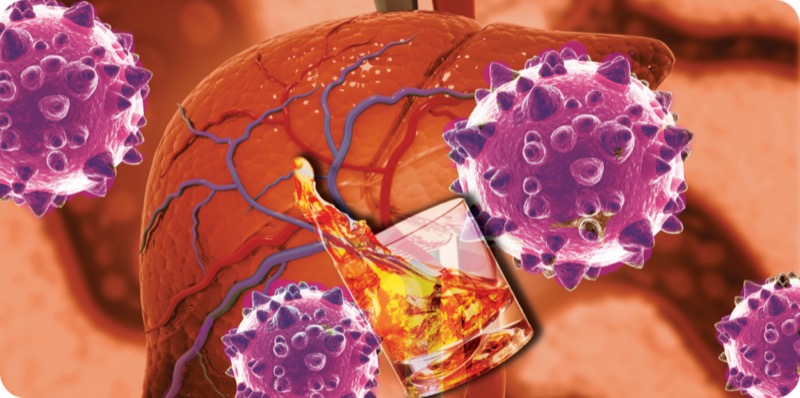
In this second part of a two-part series of Expert Picks from The Liver Meeting 2024, Ashwani Singal, MD, MS, a professor of medicine at the University of Louisville School of Medicine and transplant hepatologist at Jewish Hospital at Trager Transplant Center, in Kentucky, discusses abstracts on treatment of severe alcohol-associated hepatitis, seladelpar for primary biliary cholangitis and glucagon-like peptide-1 receptor agonists for metabolic dysfunction–associated steatotic liver disease.
Abstract 0198. Effects of timely treatment on outcomes of larsucosterol for severe alcohol-associated hepatitis (AHFIRM trial) (Stein et al)
Due to variation in time to treatment in patients enrolled in the phase 2b AHFIRM trial, investigators conducted an international randomized controlled trial of larsucosterol in patients with severe alcohol-associated hepatitis (AH) and assessed treatment efficacy in a subgroup of patients who received timely treatment (within 10 days of hospitalization).
Patients with severe AH—defined as a Model of End-Stage Liver Disease (MELD) score of 21 to 30 and Maddrey discriminant function score of at least 32—were randomized to receive 30 mg of larsucosterol (n=99), 90 mg of larsucosterol (n=101) or placebo (n=102) as one or two doses 72 hours apart.

In the subgroup of patients with timely treatment, the investigators reexamined the proportion of patients who died or had a liver transplant at 90 days. The 90-day mortality rate was 9.5% in the 30-mg larsucosterol group, 16.9% in the 90-mg larsucosterol group and 25.3% in the placebo group (30 mg vs. placebo, P=0.010; 90 mg vs. placebo, P=0.197). Liver transplant within 90 days occurred in 6.8% of the 30-mg cohort, 9.1% of the 90-mg cohort and 2.5% of patients given placebo. The P values for the composite primary end point of 90-day mortality or liver transplant were 0.053 for 30 mg and 0.602 for 90 mg of larsucosterol versus placebo.
When looking at patients with timely treatment enrolled at U.S. sites only, sites that had a shorter median time to treatment saw a 90-day mortality rate of 7.0% in the 30-mg larsucosterol group, 13.6% in the 90-mg larsucosterol group and 29.8% in the placebo group (30 mg vs. placebo, P=0.002; 90 mg vs. placebo, P=0.028). Liver transplant within 90 days was seen in 8.8% of patients taking 30 mg, 10.6% of those taking 90 mg and 3.5% of those given placebo. Thus, the P values for the primary end point were 0.015 for 30 mg of larsucosterol and 0.155 for 90 mg of larsucosterol versus placebo.
These results indicate that “patients treated within 10 days had better outcomes, especially in the 30-mg larsucosterol group,” said Lance Stein, MD, the medical director of Piedmont Hospital Transplant Services, in Atlanta, who led the study.
Dr. Singal: In the initial AHFIRM study results, larsucosterol did not achieve the primary end point of 90-day mortality reduction overall, but the intervention was significantly effective in patients enrolled from the United States. This reanalysis based on heterogeneity in time to treatment initiation shows that patients who start the medication within the first 10 days of admission to the hospital are likely to get more benefit. The findings also confirm the basis for better response in American versus European patients in the initial AHFIRM study, given the shorter time to treatment in the United States.
Abstract 0164. Efficacy and safety of seladelpar in patients with primary biliary cholangitis and compensated cirrhosis in the phase 3 placebo-controlled RESPONSE trial (Villamil et al)
Investigators reported additional biochemical and safety results from the phase 3 RESPONSE trial (ClinicalTrials.gov Identifier: NCT04620733) of seladelpar, a peroxisome proliferator–activated receptor-delta agonist, in patients with primary biliary cholangitis (PBC) with or without cirrhosis.
Patients eligible for the trial included those who had intolerance or inadequate response to ursodeoxycholic acid (UDCA), alkaline phosphatase (ALP) at least 1.67 times the upper limit of normal, alanine aminotransferase (ALT)/aspartate aminotransferase no more than three times the upper limit of normal, and total bilirubin no more than twice the upper limit of normal.
Participants were randomized to receive 10 mg of seladelpar daily (n=128) or placebo (n=65) for 12 months, with 14% of patients in each arm having cirrhosis (all Child-Turcotte-Pugh class A) (n=27 total).
Among patients with cirrhosis, the change in ALP from baseline to 12 months was a decrease of 121.4 U/L in the seladelpar group versus an increase of 23.2 U/L in the placebo group. Among patients without cirrhosis, the change in ALP was a decrease of 134.8 U/L for seladelpar versus a decrease of 18.0 U/L for placebo. “Rapid” decreases in ALP were seen within one month and were sustained through 12 months, according to Alejandra Villamil, MD, of Hospital Italiano de Buenos Aires, in Argentina, who led the study.
A similar pattern was seen for changes in gamma-glutamyl transferase: In patients with cirrhosis, seladelpar resulted in a decrease of 76.1 U/L, versus an increase of 10.3 U/L with placebo; in patients without cirrhosis, seladelpar resulted in a decrease of 112.4 U/L versus a decrease of 23.4 U/L with placebo.
Dr. Villamil also said there were “mild decreases” in ALT, “which were sustained,” but she noted that most patients had near-normal ALT at randomization. In addition, she said, globally, “total bilirubin remained stable both among patients with and without cirrhosis” over 12 months, as did the mean international normalized ratio and MELD score.
Safety results generally were similar across patients treated with seladelpar and placebo, regardless of cirrhosis status. No treatment-related serious adverse events (AEs) were seen in any patient, nor did investigators observe renal-related AEs.
Dr. Singal: The safety and efficacy of seladelpar in this randomized controlled trial of 27 patients with PBC with cirrhosis justify its use as an add-on to UDCA in nonresponders to UDCA or as an alternative for patients who are intolerant to UDCA treatment. Clearly, studies are needed to validate these findings in a larger population and to determine the efficacy and safety of seladelpar in those with decompensated cirrhosis with Chiild-Turcotte-Pugh classes B or C.
Abstract 0203. Use of glucagon-like peptide 1 receptor agonists in patients with MASLD in a real-world setting is associated with slower disease progression and lower all-cause mortality (Barritt et al)
Using data from the TARGET-NASH cohort, researchers examined the association of glucagon-like peptide-1 receptor agonist (GLP-1) use with metabolic dysfunction–associated steatotic liver disease (MASLD) progression and mortality. The investigators included adults who had used GLP-1s for at least one year and had at least six months of follow-up data. Patients who had undergone liver transplantation or had hepatocellular carcinoma were excluded from the analyses.
A total of 4,219 patients were included: 1,311 with MASLD (86 GLP-1 users); 1,331 with metabolic dysfunction–associated steatotic hepatitis (MASH) (74 GLP-1 users), and 1,577 who had MASH with cirrhosis (215 GLP-1 users).
GLP-1 users and nonusers were similar ages within each MASLD, MASH and MASH with cirrhosis patient population, while GLP-1 users who had MASH with cirrhosis were more likely to be female than nonusers. GLP-1 users were more likely to have type 2 diabetes and a higher body mass index than nonusers, and users with MASH or MASH with cirrhosis were more likely to have hypertension than nonusers.
Among GLP-1 users, 20% experienced progression from compensated to decompensated cirrhosis, with a 24.2-month median time of progression. Among GLP-1 nonusers, 23% of patients progressed to decompensated cirrhosis, with a median time of progression of 21.2 months. Factors associated with an increased likelihood of progression to decompensated cirrhosis in those with MASH and compensated cirrhosis included no use of GLP-1 (hazard ratio [HR], 1.69; 95% CI, 1.16-2.46), female sex (HR, 1.309; 95% CI, 1.01-1.70) and hypertension (HR, 1.347; 95% CI, 1.01-1.79).
{RELATED-VERTICAL}In addition, 5% of GLP-1 users with MASLD, MASH, or MASH with cirrhosis died, versus 6% of nonusers. Factors associated with an increased likelihood of all-cause mortality included no use of GLP-1 (HR, 2.28; 95% CI, 1.43-3.60); age 61 years or older (HR, 1.746; 95% CI, 1.341-2.273); non-Hispanic white ethnicity (HR, 1.671; 95% CI, 1.237-2.256); type 2 diabetes (HR, 2.263; 95% CI, 1.689-3.032); and hypertension (HR, 2.229; 95% CI, 1.635-3.037).
Dr. Singal: Most patients were excluded from phase 3 trials of GLP-1s if they had cirrhosis, so it is very encouraging to see, based on these observational data, that it is safe to use GLP-1s in patients with compensated cirrhosis and, furthermore, that these patients will probably get benefit. Other data are also emerging to show lower rates of decompensation with use of GLP-1 agonists.
A recent paper in the Journal of Hepatology looked at survodutide, a glucagon and GLP-1 receptor agonist, in compensated and decompensated cirrhosis (2024;81[5]:837-846). In both groups of patients, the drug was safe and its bioavailability was adequate. So, I think this observational study by Barritt et al and the phase 1 survodutide study are encouraging and suggest that providers should consider GLP-1s in patients with cirrhosis. Clearly, we need randomized studies, especially in those with decompensated, more advanced disease.
—Compiled and written by Natasha Albaneze, MPH

